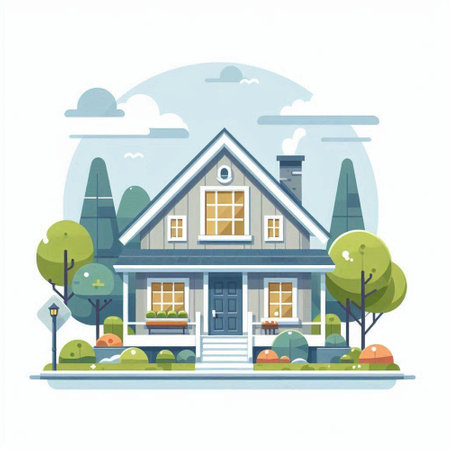1. Understanding the Importance of Lighting in Small Spaces
Lighting plays a major role in how we experience our homes—especially when space is limited. In small living areas, smart lighting choices can make a huge difference in how open, functional, and comfortable the space feels. The right lighting design doesn’t just brighten a room—it can visually expand it, improve functionality, and even boost your mood.
How Lighting Affects the Perception of Space
In compact spaces like studio apartments, small bedrooms, or tiny kitchens, poor lighting can make the area feel cramped and closed-in. On the other hand, well-placed lights can create an illusion of more space by highlighting walls, ceilings, and key focal points. This visual trick makes rooms feel airier and more open without knocking down any walls.
Main Benefits of Good Lighting in Small Areas
| Benefit | Description |
|---|---|
| Visual Expansion | Brightens corners and emphasizes depth to make the room look larger. |
| Enhanced Functionality | Improves visibility for tasks like cooking, reading, or working from home. |
| Mood Enhancement | Creates a cozy, inviting atmosphere that supports relaxation and productivity. |
The Role of Natural vs. Artificial Light
If your small space has access to natural light—like through a window or skylight—take full advantage of it by using sheer curtains or reflective surfaces to let more daylight in. When it comes to artificial lighting, layering is key. Combining ambient (general), task (focused), and accent (decorative) lighting helps create depth and dimension that visually opens up the room.
Quick Tip:
Use mirrors strategically to reflect both natural and artificial light throughout the space—it’s one of the oldest tricks in the book for making any room feel bigger.
2. Choosing the Right Types of Lighting
When decorating or renovating a small space, lighting plays a crucial role in making the area feel larger and more inviting. Understanding the different types of lighting—ambient, task, and accent—is key to creating a well-lit room that feels open and functional. Each type serves a specific purpose, and when used together strategically, they can transform even the smallest rooms into bright, stylish spaces.
Understanding the Three Main Types of Lighting
| Type of Lighting | Purpose | Common Fixtures |
|---|---|---|
| Ambient Lighting | Main source of overall light in a room | Ceiling-mounted fixtures, recessed lights, LED panels |
| Task Lighting | Focused light for specific activities like reading or cooking | Desk lamps, under-cabinet lights, pendant lights |
| Accent Lighting | Highlights features or adds mood to a space | Wall sconces, track lighting, spotlights |
How to Layer Lighting for Small Spaces
The trick to maximizing light and space perception is layering. Start with ambient lighting to provide general illumination. Then add task lighting in areas where you need direct light—like over kitchen counters or next to your favorite reading chair. Finally, use accent lighting to draw attention to artwork, architectural details, or even a cozy corner.
Tips for Strategic Lighting Combinations:
- Avoid harsh overhead-only lighting: It can cast shadows and make a room feel smaller.
- Add wall-mounted fixtures: These save floor space while adding both task and accent lighting.
- Select light-colored lampshades: They diffuse light gently and help spread brightness.
The Power of Dimmers and Adjustable Fixtures
Dimmers are an easy upgrade that give you full control over your room’s mood. Adjustable fixtures like swing-arm lamps or pivoting sconces allow you to direct light exactly where you need it without crowding the room with extra furniture or bulky lamps.
A Quick Guide to Light Bulb Choices:
| Bulb Type | Description | Best For |
|---|---|---|
| LED | Energy-efficient and long-lasting; available in various color temperatures | Main lighting, task areas |
| CFL | Saves energy but less dimmable; slower warm-up time | Lamps and ceiling fixtures |
| Edison-style (Vintage) | Aesthetic appeal with warm glow; less bright overall | Mood lighting and accents |
The right combination of lighting types doesn’t just brighten up small spaces—it shapes how those spaces feel and function. A thoughtful mix helps define zones within rooms, creates visual interest, and most importantly, makes your home feel bigger than it actually is.

3. Best Light Fixtures for Limited Spaces
When youre working with a small space, every square foot counts. Choosing the right light fixtures can make your room feel larger, brighter, and more functional—without cluttering the area. Here are some smart lighting solutions that combine style and practicality.
Wall Sconces: Stylish and Space-Saving
Wall sconces are mounted directly onto the wall, freeing up floor and table space. Theyre perfect for bedrooms, bathrooms, or hallways where every inch matters. Many modern designs come with adjustable arms or swing mechanisms, allowing you to direct light where its needed most.
Benefits of Wall Sconces
- Free up surface and floor space
- Provide ambient or task lighting
- Add a decorative touch to blank walls
Recessed Lighting: Hidden but Powerful
Also known as can lights or downlights, recessed lights are installed into the ceiling so they don’t protrude into the room. This makes them ideal for low ceilings or compact spaces like kitchens, bathrooms, and entryways.
Why Choose Recessed Lighting?
- Creates a clean, uncluttered look
- Distributes light evenly across the room
- Ideal for layering with other types of lighting
Multipurpose Lamps: Function Meets Flexibility
In small apartments or studios, every item needs to pull double duty. Look for lamps that offer more than just light—like those with built-in shelves, USB ports, or adjustable brightness settings. Floor lamps with slender profiles or clip-on desk lamps are also great options when space is tight.
Popular Multipurpose Lamp Features
| Lamp Feature | Description | Best For |
|---|---|---|
| Shelf Lamp Combo | Lamp with built-in storage shelves | Living rooms or studio apartments |
| Dimmable Touch Controls | Adjust brightness levels easily | Bedrooms or workspaces |
| USB Charging Ports | Charge devices without extra outlets | Nightstands or home offices |
| Clip-On Lamps | Attach to headboards or desks to save space | Dorms or small bedrooms |
Smart Placement Tips
No matter which fixture you choose, placement is key in maximizing both light and space. Use lighting to highlight vertical lines (like tall bookshelves) to draw the eye upward. Place lamps near mirrors to reflect more light around the room. And remember—layering different types of light creates depth and prevents shadows.
Quick Tips:
- Avoid bulky chandeliers in low-ceiling rooms
- Add under-cabinet lights in kitchens to free up counter space
- Use LED bulbs to reduce heat and energy use in compact areas
Selecting the right lighting fixtures not only saves physical space but also enhances how your home feels. With a little creativity and thoughtful design, even the smallest rooms can shine bright.
4. Using Natural Light to Your Advantage
Natural light can make even the smallest spaces feel bigger, brighter, and more open. By strategically using daylight, you can reduce your need for artificial lighting during the day and create a more inviting atmosphere. Here are some easy ways to maximize natural light in small rooms:
Choose the Right Window Treatments
The type of window coverings you use can either block or enhance natural light. To let the most light in, opt for lightweight and sheer fabrics. Avoid heavy drapes that absorb light and make a room feel smaller.
| Window Treatment | Light Effect | Best For Small Spaces? |
|---|---|---|
| Sheer Curtains | Diffuse and soften incoming light | ✔ Yes |
| Roman Shades (light fabric) | Allow filtered light with privacy | ✔ Yes |
| Blackout Drapes | Block all light | ✘ No |
| No Treatment (bare windows) | Maximize full sunlight | ✔ Yes, if privacy isnt an issue |
Add Mirrors to Reflect Light
Mirrors are a powerful tool in small-space lighting design. Place mirrors across from windows to reflect natural light deeper into the room. This not only brightens the space but also gives the illusion of more square footage.
Tips for Using Mirrors Effectively:
- Use large mirrors: The bigger the mirror, the more light it reflects.
- Create a gallery wall with mirrored panels: It adds style while bouncing light around.
- Add mirrored furniture or decor: Subtle reflections from glossy surfaces help amplify brightness.
Create a Layout That Supports Daylight Flow
The way you arrange furniture affects how well natural light moves through your space. Keep windows unobstructed and avoid placing bulky furniture directly in front of them. Use open shelving or low-profile pieces that allow light to travel freely.
Clever Layout Strategies:
- Avoid blocking windows: Let daylight enter without obstructions.
- Select glass or acrylic furnishings: These materials allow light to pass through and reduce visual clutter.
- Create open sightlines: Arrange furniture to keep pathways clear and open up views across the room.
A few simple changes can make a big difference when it comes to natural lighting in tight spaces. With smart window treatments, well-placed mirrors, and thoughtful furniture layout, your small room can look and feel much larger than it is.
5. Color Temperature and Bulb Selection Tips
When lighting a small space, the color temperature of your light bulbs plays a major role in how large or cozy the room feels. Color temperature is measured in Kelvins (K), and it affects both the mood of the room and how colors appear on walls, furniture, and decor.
Understanding Color Temperature
There are three main ranges of color temperature commonly used in homes:
| Color Temperature (Kelvin) | Light Appearance | Best For |
|---|---|---|
| 2700K – 3000K | Warm White | Living rooms, bedrooms – creates a cozy, inviting feel |
| 3500K – 4100K | Cool White / Neutral White | Kitchens, bathrooms – balances clarity and comfort |
| 5000K – 6500K | Daylight | Laundry rooms, garages, offices – enhances focus and brightness |
Mood and Space Perception
Softer warm tones (2700K–3000K) can make a room feel smaller but cozier. This works well in spaces where comfort is key. On the other hand, cooler tones (4000K–5000K) mimic natural daylight, making small rooms feel more open and airy—great for compact kitchens or workspaces where you want to visually expand the space.
Tip:
If you’re working with limited square footage, consider using cooler white bulbs (around 4000K) to help reflect more light and give the illusion of a larger area.
Selecting the Right Bulbs
The type of bulb you choose also impacts efficiency and light quality. Here’s a quick comparison:
| Bulb Type | Lifespan | Energy Efficiency | Dimmable? |
|---|---|---|---|
| LED | 15,000+ hours | High | Yes (check packaging) |
| CFL | 8,000 hours | Moderate | No/Some models only |
| Incandescent | 1,000 hours | Poor | Yes |
The Best Choice for Small Spaces:
An LED bulb with a color temperature between 3500K and 4500K offers energy savings, long life, and a bright yet soft light that makes small interiors feel bigger and more vibrant.
Avoid Mixing Temperatures
If possible, use the same color temperature throughout connected spaces. Mixing warm and cool lights can make small areas feel disjointed or cluttered.
Selecting the right color temperature and bulb type is an easy but powerful way to enhance your small space—making it feel brighter, more comfortable, and even more spacious.


